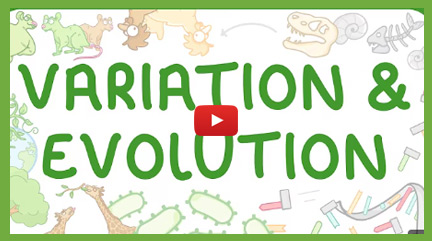
Variation & Evolution
This topic explores how differences between individuals arise and how species change over time. Learn about genetic and environmental variation, how natural selection works, and the process of evolution. It also covers selective breeding, genetic engineering, and how new species can develop.
What Is Variation?
Variation refers to the differences between individuals of the same species. These differences can affect things like height, eye colour, or disease resistance.
There are two main types:
- Genetic variation – caused by differences in DNA, inherited from parents.
- Environmental variation – caused by surroundings, e.g. diet, climate, or lifestyle.
Some traits, like body weight or intelligence, are influenced by both genetic and environmental factors. These observable traits are known as phenotypic variation.
Mutations and Genetic Change
Mutations are random changes in DNA. Most have little or no effect, but occasionally a mutation leads to a new characteristic. If this change gives an advantage, it may spread through the population over generations — a key part of evolution.
Revision Notes

The Cornell method is like a supercharged note-taking system that helps you ace your revision!
Print out our blank revision notes pages to help you revise.
How to make effective revision notes with the Cornell method.
Exam Questions & Answers

Download and print off practice our FREE worksheet with exam style questions on Cell Biology.
Evolution by Natural Selection
Evolution is the gradual change in species over time. It’s driven by natural selection, a theory developed by Charles Darwin. His idea was that:
- Individuals with advantageous traits are more likely to survive and reproduce.
- These traits are passed to offspring.
- Over time, this can lead to changes in the species.
Other scientists, like Lamarck, had different hypotheses. He suggested that characteristics developed during a lifetime could be inherited — but this idea was later disproved.
Speciation and Extinction
Over long periods, natural selection can lead to the formation of new species – this is called speciation. It often happens when populations become isolated (e.g. by geography) and evolve differently.
Sometimes, species fail to adapt and become extinct, often due to rapid environmental change, new predators or diseases, or competition for resources.
Fossils and the History of Life
Fossils are remains of organisms from millions of years ago. They provide evidence for evolution.
Fossils can form through:
- Gradual replacement by minerals
- Casts and impressions in rocks
- Preservation in places where decay can’t occur (like ice or amber)
The fossil record is incomplete, but it still helps scientists study how life has changed over time.
Classification and Evolutionary Trees
To study how organisms are related, scientists use classification. The modern system groups organisms based on similarities in structure and genetics.
- The binomial system gives every species a two-part Latin name (e.g. Homo sapiens).
- Evolutionary trees show how species are related through common ancestors and how they have evolved over time.
Links for Learning
Bitesize: Evolution
Revision Science: Evolution & Extinction
Live Science: Darwin's Theory of Evolution
Bitesize: Variation
Revision World: Variation & Mutation
Bitesize: Evidence for evolution - rock fossils
Bitesize: Linnaean system of classification
Bitesize: Variation test
Bitesize: Evolution test
Bitesize: Classification of living organisms test
Revision Notes

The Cornell method is like a supercharged note-taking system that helps you ace your revision!
Print out our blank revision notes pages to help you revise.
How to make effective revision notes with the Cornell method.


